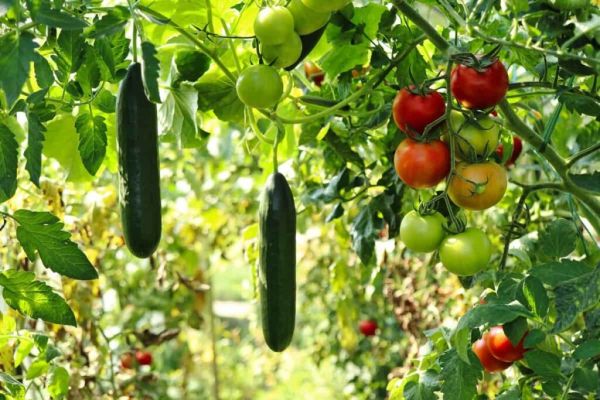Vegetable Companion Chart in India: What to Plant and What Not to Plant
Vegetable Companion Chart in India: What to Plant and What Not to Plant

You need extra room in your garden if you want your plants to thrive. The steps of companion planting can be easily followed and repeated. Plants can use their natural defenses to help each other flourish in a companion garden, making it easier to cultivate organic produce. All plants, from veggies and herbs to flowers, benefit from having a neighbor.
However, much as with humans, not just any partner will do. If you put the incorrect plants near one another, you might end up hurting the whole garden. A key component of growing a healthy and beautiful garden is knowing which plants complement one another. Your vegetable garden will thrive with the correct companion planting, which has many fantastic advantages. Below we learn about vegetable companion charts in India, what to plant and what not to plant beside your vegetables and some of the best companion plants.
Vegetable companion chart in India
What are the advantages of vegetable companion planting?
Using companion planting, you can use some plants to shield others from harm. If a pest-hating plant is placed around an area of desirable vegetation, the pests will have a harder locating it. Herbs and flowers, for example, often have an aroma that is unpleasant to pests. For instance, marigolds planted with beans can help ward off bean beetles, while marigolds planted near tomatoes can ward off the nasty Hornworm Caterpillars. As they expand, some plants can provide each other the essential support.
It’s best to wait until your corn has grown a few inches before planting your squash and beans. Beans can use corn as a trellis. The corn will use the nitrogen from the beans. In addition, as it spreads, squash acts as a weed barrier and a source of shade for the corn and bean plants below. They’re effective in warding off pests of all kinds, even one another. Companion plants for vegetables can boost the nutrition of their vegetable counterparts.
Squash and cucumber vines, for example, provide a protective shadow over their neighbors, keeping the soil cool and preventing moisture loss. This will help your garden stay healthy even if there is a prolonged lack of rainfall throughout the summer. Vining plants provide shade, retain moisture, and compete with weeds for light and nutrients. Planting cucumbers and squash in your garden is a great way to prevent weeds from taking over. Weeds cannot flourish in an environment where the soil is covered.
The rapid transmission of a disease among a plant population is facilitated by the presence of huge concentrations of the infected plant. Diversifying your garden’s plant composition can help prevent the spread of diseases by breaking up concentrated growth areas. Some plants even protect other plants from diseases. Planting maize and beans together allows the former to serve as a source of fertilizing nitrogen for the latter. Planting basil alongside tomatoes has been shown to improve the overall health of both plant species.
Insects beneficial to your garden’s health will hang out more often if they have access to tasty treats and a pleasant atmosphere. Inviting these helpful insects to your yard is as simple as spreading flowery ground cover. Clover, buckwheat, and vetch are all excellent examples of blooming cover. Selecting flowering plant species with long growing seasons is key to getting the most out of this strategy.
Any space can be filled by planting a few types of beans, tomatoes, peppers, or other types of food. By using the companion planting technique with your vegetables, you may increase the diversity of your garden while simultaneously reaping the benefits of doing so. Given the many upsides of companion veggie gardening, it’s a no-brainer to use this strategy. After all, it’s good for the plants, boosts yields, and makes organic gardening a breeze.
Can tomatoes and onions be planted together?
Like people, plants may gain strength from their interactions with one another; so-called “companion planting” is a sort of polyculture in which various crops are grown together. Benefits such as reducing the number of pests and diseases, helping with pollination, and providing a haven for helpful insects can significantly impact harvest success.
Similar to how many races, faiths, and civilizations have broadened humanity, the practice of companion planting broadened the scope of the garden. The synergy between us is powerful, but it also has the potential to expose our flaws. Tomatoes need companion plants, just like every other vegetable garden. When grown with suitable partners, tomatoes flourish and produce more fruit.
All onion family members, including chives, onions, and garlic, are excellent companion plants for tomatoes. Some say that its strong stench can drive away nuisance insects. Tomatoes are great neighbors for many vegetables, and their towering foliage provides a welcome shade for many leafy greens. Carrots are another plant that complements tomato gardens. Tomatoes and carrots can be planted simultaneously, with the former growing in tandem with the latter until both are ready to be harvested simultaneously.
Can tomatoes and cucumbers be planted together?
In a greenhouse setting, especially, tomato plants and cucumber plants are excellent companion plants due to their shared growth conditions. They need about the same time to germinate, water, and develop to maturity. They can be easily grown next to one another since they have comparable needs for water and light.
What grows well with cucumbers?
The secret to a successful cucumber crop is protecting your plants from pests and diseases, which you can do by including plants that do well near cucumbers in your kitchen garden design. Companion planting is preferable to monoculture because it results in a more diverse array of plant life. Although our knowledge of the former’s advantages for plants is still limited, it is apparent that this is the ideal situation for any garden, potager garden, or greenhouse where fruit or vegetables are grown.
Fruits, vegetables, flowers, and herbs all attract various pollinators when grown in a healthy environment together. Because it is more difficult for pests and diseases to target the plants they intend to devour or set up a home or nursery in; the soil is not drained of nutrients as rapidly as it would be if just one crop were planted in an area. In addition, the spread of disease is slowed since fewer instances of a single plant species growing near one another.
So, if you’re keen on cucumber companion planting, we’ve got many ideas on what to plant near your cucumber patch. Cucumbers pair well with many other fruits, flowers, and herbs. Plants like peas, maize, beans, and lentils are in your garden because their roots improve soil fertility by fixing atmospheric nitrogen. Root vegetables like radishes, beets, carrots, and onions complement cucumbers since they do not expand and compete for space.
Moreover, fertile soil is essential for growing both root vegetables and cucumbers. Flowers like marigolds and nasturtiums must deter beetles, thrips, and other pests. Sunflowers, tall and robust, can be used as trellises for cucumber plants. Both oregano and dill are effective insect repellents, and dill also attracts predatory insects that can help clean up the garden. However, some plants should not be permitted to coexist with others, just as there are plants that are wonderful companions together.
Potatoes: These tubers fight for nutrients and water with cucumbers and should not be grown in the same garden. Plant sage somewhere else since it slows down cucumber development. Most mint types are invasive, meaning they’ll take over your garden and starve your cucumbers of room and nutrition. Don’t grow melons next to your cucumbers since the fruits of these plants attract insects that eat the cucumbers’ delicate skin.
Can I plant potatoes near tomatoes?
The answer is no; potatoes and tomatoes do not belong in the same garden. Potatoes and tomatoes can come from the nightshade family, but they have distinct pH needs in the soil. Insects that feed on potatoes and tomatoes can transfer diseases like early blight and late blight, for example, from one plant to another. Having potatoes and tomatoes in your garden is possible, even though they shouldn’t be planted next to each other, but only if you take precautions against diseases.
Let’s look at what plants require to survive, what diseases they get, and how to avoid them in your garden. Tomatoes and potatoes are not a good combination for planting. One of the primary factors is the acidity or alkalinity of the soil. Like many other garden plants, tomatoes thrive in soil with a pH between 6.0 and 6.8. However, potatoes thrive on soil with a pH between 4.8 and 5.5. If you attempt to cultivate two different plants in the same soil, you’re certain to make at least one of them unhappy.
Getting potatoes and tomatoes to full maturity in the same soil may not be easy without harming them. The potato tuber develops below the soil, while the plant’s leaves are a visible indicator of its presence above ground. If potatoes are planted too closely to tomato plants, their growth can eventually obstruct the tomatoes’ roots.
You can accidentally injure the plant’s roots if you collect potatoes next to a tomato plant. Keep in mind that there is a considerably larger potential for disease transmission between potatoes and tomatoes if grown near one another. Early blight and late blight are the most devastating diseases affecting potatoes and tomatoes.
What should not be planted near carrots?
Carrots should not be planted near other root crops like dill, celery, or parsnips. Planting root vegetables too close together can cause competition and a poorer yield at harvest time. Root crops all need high quantities of phosphorus to grow. Carrots and dill aren’t the best of companions since dill’s flowers might potentially pollinate nearby carrots and produce unappealing offspring. Dill and parsley suffer from the presence of lacewings and parasitic wasps attracted to carrots. Carrot fly attracts celery, so don’t put them near your carrots.
Sage and rosemary both have very aromatic leaves that can be used to cover up the smell of carrots and keep the carrot fly at bay. Chives, related to onions, are another option for deterring carrot flies. They also have the additional bonus of making carrots taste better. The roots of chives aren’t very deep, so they don’t crowd out carrots in the garden. Lettuce, in contrast to carrots, which grow underground and have little leaves, has short roots and many leaves that spread out over the ground.
This makes lettuce a fantastic space-saving carrot companion plant, especially in modest gardens. Lettuce leaves block out light more effectively than carrot leaves, so they’ll help keep the carrots in the shadow and shield them from certain weeds. Carrots thrive in nitrogen-rich soil, which is produced by growing beans and peas. If you go this route, don’t add onions since they will stunt the development of your peas and beans.
What grows well with spinach?
There are a variety of methods in which companion planting helps a garden thrive. Both harmful insects and helpful pollinators can be deterred by this method. For example, the “Three Sisters” planting of squash, beans, and maize has long been recognized as an example of how companion plants can benefit other crops. Corn anchors the bean plants, legumes fix atmospheric nitrogen, and squash’s massive leaves shield the ground around the plant’s roots from the sun.
If you’re growing spinach with other plants, keep in mind that spinach has specific requirements. The seeds of spinach, which thrive in a mild climate, should be planted in early spring. In addition to preferring wet, nitrogen-rich soil, this plant has a deep taproot, doesn’t grow very tall, and doesn’t need any staking. Weeding or hand-pulling weeds around spinach can harm the plant’s roots; thus, preventing weed growth is essential.
Similarly, spinach matures quickly, so it’s best to plant it among slower-maturing crops like tomatoes and peppers. If the spinach is picked while it is slower to grow, the later-maturing plants will have more time to develop. Spinach grows well with beans and peas. Since legumes grow taller than spinach, they provide needed shade and prevent the spinach from bolting. Other vegetables and fruits that go well with spinach include cabbage, chard, cauliflower, onion, and strawberries.
Plants with strong aromas and vivid colors repel harmful insects and lure in helpful pollinators. The utilization of flowering plants, which serve the twin objectives of improving the aesthetics of an area and attracting beneficial insects, is one of the fundamentals of integrated pest management (IPM). IPM reduces or eliminates the demand for insecticides. Marigolds help prevent nematodes in vegetable gardens, according to research. The French marigold, Tagetes patula, is the best choice for warding off nematodes of all kinds.
Generally speaking, annual flowers are excellent companion plants since they can be relocated about the garden yearly, much like other plants. Nasturtiums, another annual, are a delicious addition to a spinach garden as companion flowers since they deter pests while still being tasty. Zinnias are great spinach companion plants that can give needed shade and repel predatory bugs. Finally, many beneficial insects that eat pests are drawn to the cosmos. The increased height of these plants will also protect the spinach from the sun.
Vegetable companion chart in India
| Vegetable |
Plant with |
Avoid
planting with |
Zucchini /
summer squash |
Dill, Oregano, Beans,
Parsley, Pepper, Radish |
Potato, Pumpkin |
| Tomato |
Celery, Carrot,
Asparagus, Parsley,
Marigold |
Corn, Potato,
Kohl Rabi, Fennel,
Cabbage |
| Spinach |
Cauliflower, Celery,
Eggplant |
Leek, Strawberry |
| Radish |
Peas, Lettuce,
Cucumber, Nasturtium,
Beets, Spinach,
Squash, Tomatoes,
Carrots, Melons, Beans |
Potato |
| Pumpkin |
Corn, Marigold |
Potato |
| Potato |
Cabbage, Peas,
Beans, Corn, Eggplant |
Pumpkin, Squash,
Cucumber, Sunflower |
| Pea |
Carrot, Corn,
Beans, Cucumber, Radish |
Onion Family |
| Onion |
Broccoli, Cabbage,
Bean Sprouts,
Lettuce, Strawberry,
Tomato |
Bean, Pea |
| Melon |
Radish, Corn,
Marigold |
Potato |
| Lettuce |
Peppers, Garlic,
Onion, Asparagus,
Carrots, Radishes,
Strawberry, Marigold |
Beans,
Beetroot,
Parsley |
| Leek |
Celery, Carrot,
Strawberry |
Beans, Peas,
Spinach |
| Cucumber |
Celery, Lettuce,
Pea, Bean,
Radish, Marigold |
Potato,
Cauliflower,
Basil |
| Corn |
Cucumber, Melon,
Bean, Pea,
Pumpkin, Potato,
Radish |
Tomato |
| Celery |
Leek, Onion,
Cabbage, Spinach,
Tomato |
Parsnip, Potato |
| Cauliflower |
Celery, Oregano,
Beans, Marigold |
Potato, Strawberry,
Nasturtium,
Peas, Tomato |
| Carrot |
Pole Beans, Lettuce,
Bush Beans, Onion,
Pea, Radish, Tomato |
Dill, Parsnip, Chives |
| Cabbage |
Potato, Oregano,
Beetroot, Sage |
Strawberry, Tomato |
| Brinjal |
Capsicum, Bean,
Potato, Spinach |
Pomegranate, Kiwi,
Figs, Curry Leaves |
| Brussel sprouts |
Potato, Thyme |
Strawberry |
| Broccoli |
Chamomile, Dill,
Celery, Rosemary,
Marigold |
Oregano,
Strawberry |
| Beets |
Lettuce, Onion,
Brassicas, Sage |
Bean (pole) |
| Broad Beans |
Brassicas, Carrot,
Celery, Corn,
Lettuce, Potato |
Fennel |
| Beans |
Carrot, Cabbage,
Cauliflower,
Cucumber |
Chives, Leek,
Garlic |
| Asparagus |
Basil, Tomato,
Nasturtium, Parsley |
Onion, Garlic,
Potato |
Posted
2 years ago
No comments yet! Why don't you be the first?










Add a comment